PREPARING FOR THE DAY LANDON MAYER
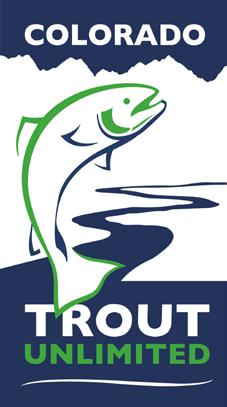
THE ENDLESS RIVER JACK BOMBARDIER



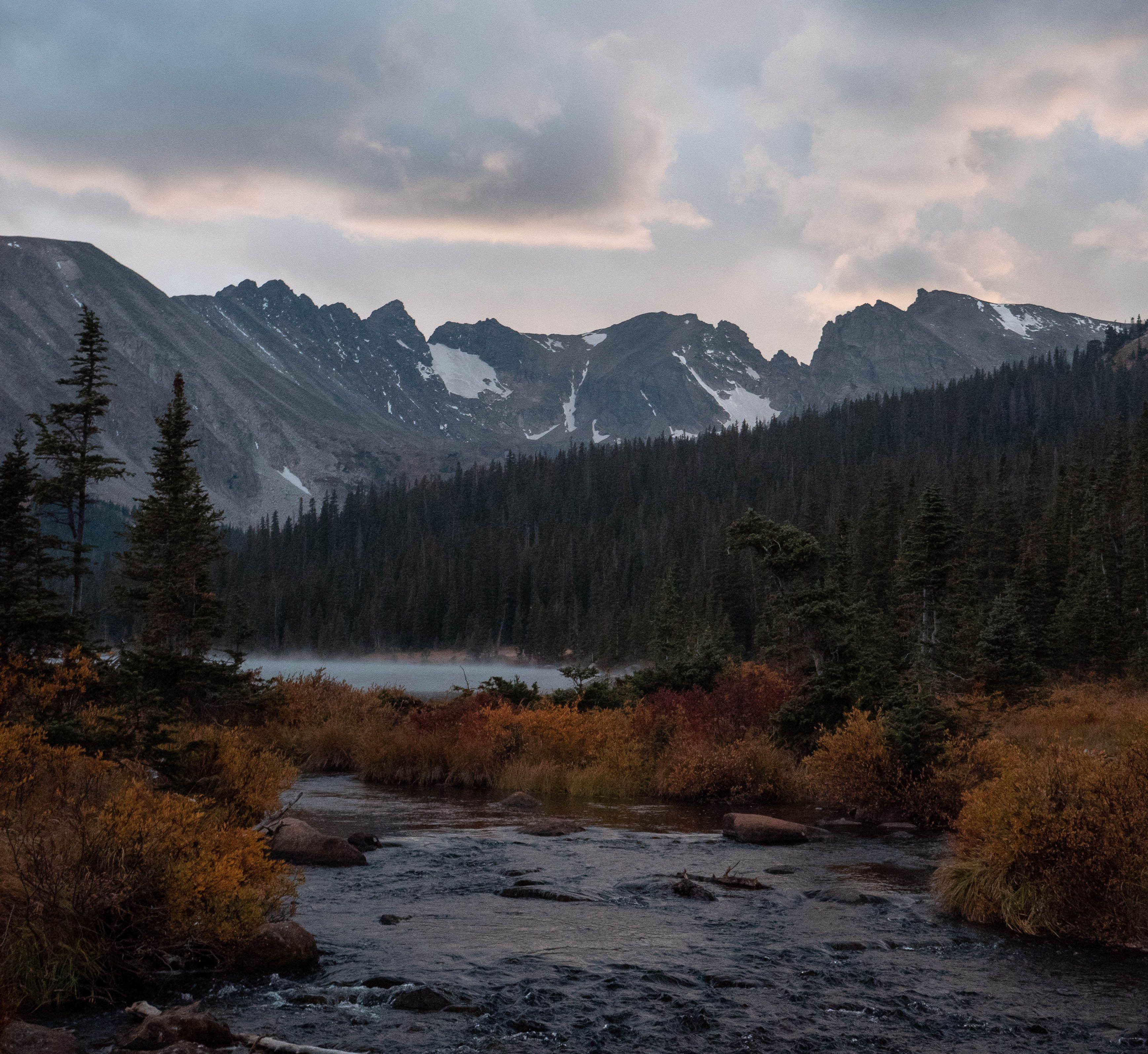


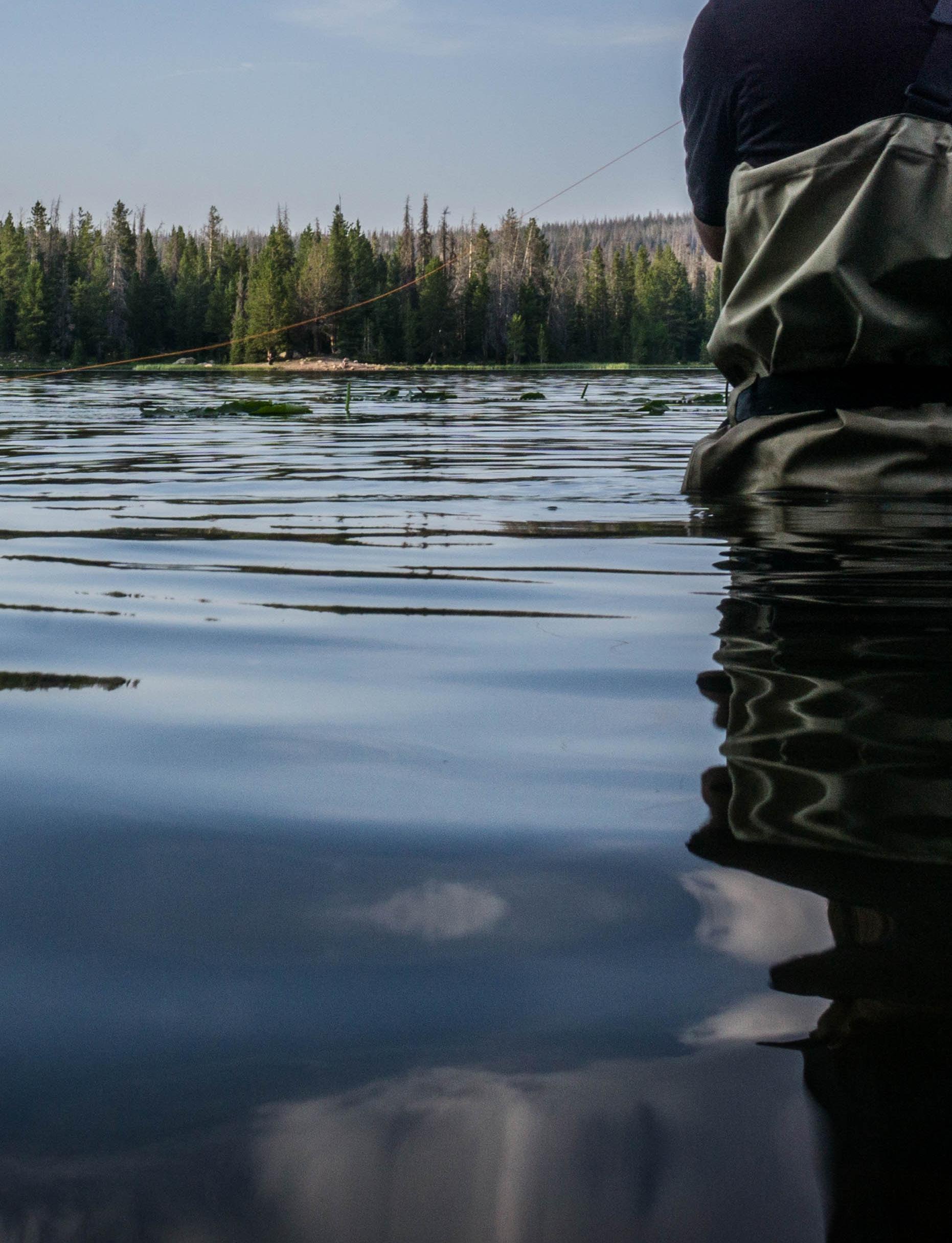
Spend your time fiddling with flies, not with software. We've been designing High Country Angler for over a decade. reimagine designs (816) 892-0810 david@reimaginedesigns.com Call or email us for a free estimate for all print and website design.


SPRING 2023 VOLUME 20 • ISSUE 2 MAGAZINE CONTENTS 08 PREPARING FOR THE DAY BY LANDON MAYER 14 85 MILES OF MAGIC BY BRIAN LA RUE 22 EDNA SAMPLING SURPRISES TIC STUDENTS BY JOHN DAVENPORT 28 BRINGING HOME THE GOLD BY JOEL EVANS 32 YOU DON’T KNOW WHAT YOU ARE MISSING BY HAYDEN MELSOP 34 THE ANATOMY OF A EURO NYMPH BY PETER STITCHER 38 HUNTING FOR TROUT WITH A 30-06 BY JOEL EVANS 40 ROSS REELS GREENBACK REEL BY COLORADO TU STAFF 44 THE ENDLESS RIVER BY JACK BOMBARDIER 48 THE SCOURGE OF FOREVER CHEMICALS BY JOHN NICKUM
PUBLISHERS
Jack Tallon & Frank Martin
CONTENT CONSULTANT
Landon Mayer
EDITORIAL
Frank Martin, Managing Editor frank@hcamagazine.com
Landon Mayer, Editorial Consultant Ruthie Martin, Editor
ADVERTISING
Brian La Rue, Sales & Marketing
brian@hcamagazine.com
Direct: ( 303) 502-4019
Mark Shulman, Ad Sales Cell: (303) 668-2591

mark@hcamagazine.com
DESIGN
David Martin, Creative Director & Graphic Designer
PHOTOGRAPHY
Frank Martin, Landon Mayer, Brian LaRue, Angus Drummond
STAFF WRITERS
Frank Martin, Landon Mayer, Brian LaRue, Joel Evans, David Nickum, John Nickum, Peter Stitcher
Copyright 2017, High Country Angler, a division of High Country Publications, LLC. All rights reserved. Reprinting of any content or photos without expressed written consent of publisher is prohibited. Published four (4) times per year.
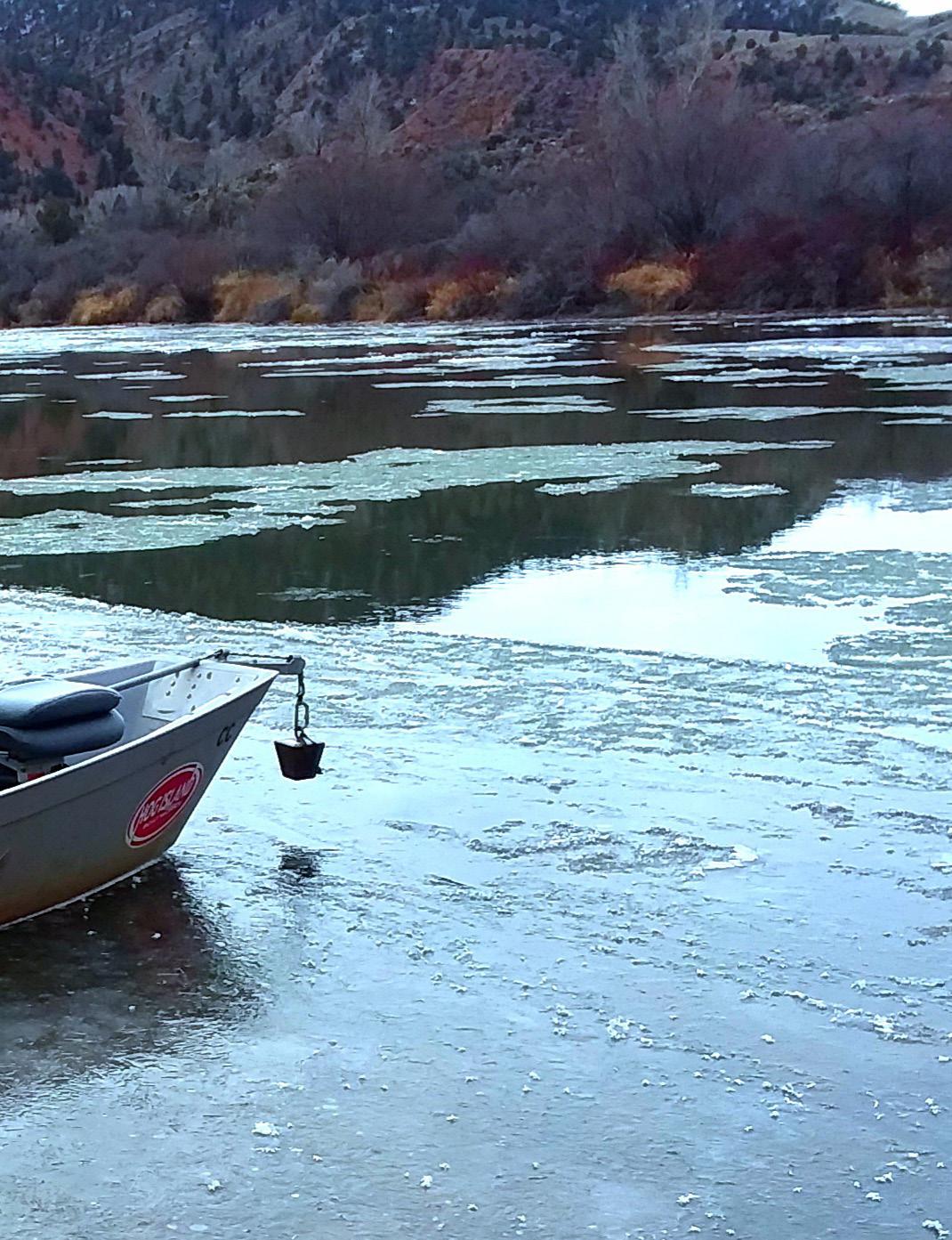
To add your shop or business to our distribution list, contact Frank Martin at frank@hcamagazine.com.
Distributed by High Country Publications, LLC 730 Popes Valley Drive Colorado Springs, Colorado 80919 FAX 719-593-0040
Published in cooperation with Colorado Trout Unlimited 1536 Wynkoop Street, Suite 320 Denver, CO 80202 www.coloradotu.org
HCA Staff ON THE COVER: LANDON MAYER
Thirteen miles southwest of Laramie 4,050± deeded, contiguous acre ranch with eight miles of the Laramie River. The property includes appealing improvements, extensive wildlife, and world-class fishing for large trout.



$21,500,000

One of the premier sporting ranches in the Sun Valley area featuring 1,226± deeded acres and 2.5± miles of fabled Silver Creek with some of the largest trout in the system. Tasteful creekside home with three bedrooms.
$15,500,000
World-class trout fishing on 2.5 ± miles of Badger Creek and hunting for elk, mule deer, and upland birds. Bordered by public lands, the ranch offers Teton views, 613± deeded acres including 130± acres of dry farmland.

$9,895,000
Encompassing a diverse mountain landscape flanking the Colorado River, this 1,512± acre ranch offers outstanding hunting and fishing with end-of-the-road seclusion, log home, and location convenient to ski resorts and Denver.
$8,500,000
A highly diversified property, offering a “blue ribbon” fishery, encompassing one mile of both banks of the San Juan River, 143± deeded acres, custom-built 3,100± square foot primary residence and 3,500± square foot guest house.
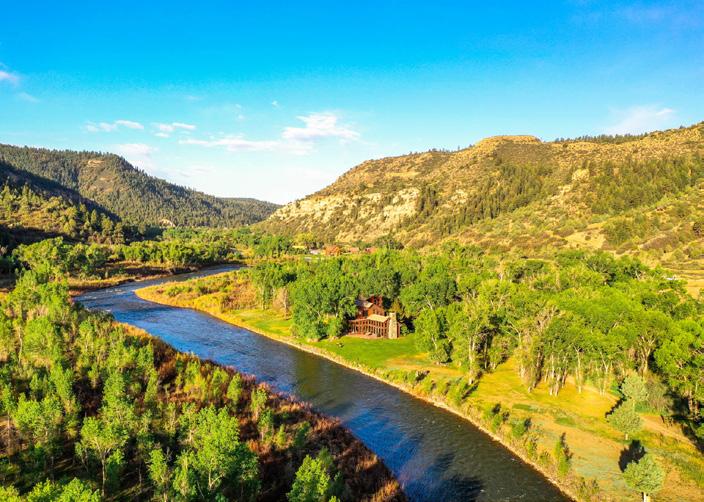
$3,950,000
With 1,400± feet of Eagle River frontage, this 37.55± acre holding is a prime candidate for those seeking live water and private amenity access close to Vail and Beaver Creek. Recently contructed 4,250 ± square foot garage.
$2,000,000
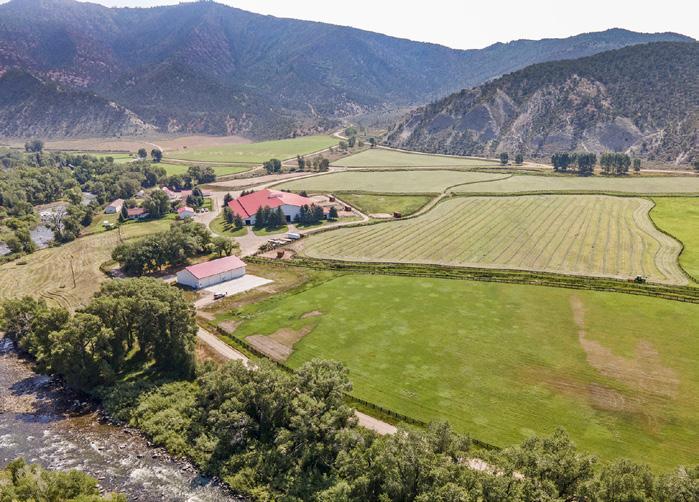
High Country Angler • Spring 2023 www.HCAezine.com 6
MARIETTA CREEK RANCH HOT SULPHUR SPRINGS, COLORADO
SAN JUAN RIVER RETREAT PAGOSA SPRINGS, COLORADO
EAGLE RIVER MEADOWS EAGLE, COLORADO
FLYING Y RANCH LARAMIE, WYOMING
BADGER CREEK CANYON RANCH FELT, IDAHO
RENEGADE RANCH SUN VALLEY, IDAHO
SALES | AUCTIONS | FINANCE | APPRAISALS | MANAGEMENT WWW.HALLANDHALL.COM | INFO@HALLANDHALL.COM | 888.557.3090

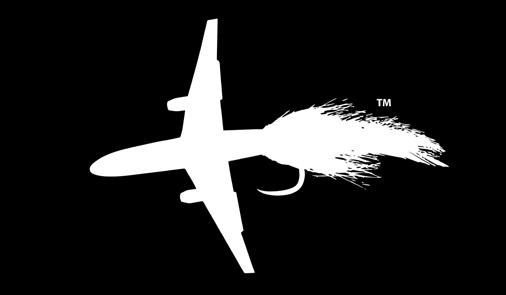




www.HCAezine.com Spring 2023 • High Country Angler 7 pescadoronthefly.com The Best Packable Fly Rod Combos on the Market. Pescador on the Fly We are a huge supporter of Trout Unlimited, and proudly send around 10% of our sales to our partners at TU. El Jefe Series Packable Fly Rods FREE Bonus Gear Pack with All El Jefe Combo Purchases While Supplies Last. A &185+ Value! Pescador on the Fly is a small, familyowned business. We keep our overhead low to pass on big savings to anglers all over the world. The El Jefe Series uses highperformance components, available from 0-10 weight and in 4- or 6-section rods. “El Jefe is The Boss of Packable Fly Rods”. Fly Fisherman Magazine Gear Review

PREPARING FOR THE DAY
by Landon Mayer
Preparation for a trip begins before I even arrive at the water. When fishing familiar waters, I try to visualize what the water looks like and reflect on past experiences. In new locations, I use a map and satellite images to determine where I think quality trout will be holding; cover, oxygen, and food supply are the trout’s most important criteria in choosing holding lies. This mental preparation is similar to an athlete’s getting “in the zone.” It is almost like you are role-playing how you will fish the water the following day. This can result in extremely positive days.
I then turn my attention to the vise. If you do not tie, concentrate on going through and evaluating your fly box. This is the best way to prepare yourself for the trip and develop a systematic plan on how you will present your flies to the trout. I prepare two dozen flies that imitate the predominant food supply in a small container (puck) for easy access while on the
stream. I call this being “on deck,” akin to a batter getting ready to step up to the plate. I also use this small container as storage for the hot flies. I am a firm

believer in speed on the river; yes, you can take the time to organize each fly in its proper place during or after each retie, but you run the risk of missing the few shots you will get at the fish in the process. You can organize your fly box after your trip or before the next day’s fishing.


I keep detailed records every month of the year of what the trout are feeding on. If you’re just getting started, one of the best books I have found to date is Dave Whitlock’s Guide to Aquatic Trout Foods. It was my “Bug Bible” when I first started fly fishing. This book is noteworthy for the detailed drawings on each page that show the insect in motion, and the format makes it easy to learn.

A good example of proper fly selection for the Winter/Spring months is match the midge hatch. I keep a good section of Tube Midges ties with a thread head, or tungsten bead for depth control. Some with a gill tuft above the eye of the hook, and some with a wing emerging out behind the thorax. This allows me to match the various stages of the hatch, and when needed, drop below a Griffith’s Gnat dry fly on a stealth dry dropper rig.
Before you even consider your equipment, don’t overlook the way you dress. Anglers often camouflage themselves to blend in with the river’s edge. Because trout see upwards in a conical path, it is important to think about what the trout will be seeing above and behind the angler. If your destination is in a canyon, match the canyon walls. If it is fall, match the changing foliage. A bluebird day requires a similar color blue.

As for equipment, I usually begin with a nymph rig. No matter what season, weather, or time of day, the odds will be in your favor because a majority of a trout’s diet is subsurface (unless the fish are feeding heavily on the surface when you first get to the water). Additionally, I rig a second rod with dry flies so I can avoid rerigging if the trout suddenly decide to feed on the surface. Some of the largest trout I have landed were caught during sporadic hatches. In addition to hatches, a break in the weather can also allow the trout to feed on the surface, where you can present a hopper or a mouse to trout that have seen nothing but subsurface food all day.
Streamers are tricky. I have yet to meet an angler
High Country Angler • Spring 2023 www.HCAezine.com 10
WWW.LANDONMAYERFLYFISHING.COM NEW VIDEO! Order Your Copy Today!
who can hit the water and nail fish on streamers all day. Streamers work only under specific circumstances. For instance, if the water suddenly increases in flow and becomes off color, trout will feel much more comfortable attacking large prey. Streamers can also serve as my cleanup method, in which I go back to a previously fished area to present the streamers, hoping wary fish that didn’t attack earlier will attack now. No matter what type of water you are on, the last two hours before nightfall bring out the large nocturnal feeders that will take a streamer consistently.
Each discipline of fly will require you to adjust the size of the rod, reel, and line setup. For dry flies I like to use lighter rods and line weights (2- to 4-weight, depending on the water) than I use when fishing nymphs or streamers to add a softer touch to the presentation. A 9-foot rod is ideal for water with room to cast and fish at fair distances. However, if I am fishing
pocket waters in tight quarters, shorter is better. Rod lengths from 7- to 8- feet help prevent snags on waters with movement from choked edges[tg1] .
The nymphing game has changed over the past five years, but the weight of the setup remains the same for the most part: 4-weights and 5-weights are still some of the most common sizes. In big waters with big fish, like the rivers in Alaska, it is not unheard of to go up to 7- or 8-weight nymph sticks for lifting power. The length of the rods can vary, too. A 9-foot rod will do for most waters and distances. Rods 10 feet or longer do come into play for larger bodies of moving water, because they have more reach and fly line control, and on still waters because they have more length for lifting and leverage during the fight. If it is feasible, having both a 9-foot stick and a 10-foot stick will cover all water types, from intimate to vast.
For streamers, 6- to 8-weight rods are common. I

www.HCAezine.com Spring 2023 • High Country Angler 11
prefer a 7-weight because it is the most versatile, allowing me to fish streamers on a river in the a.m. and then cast to pike in a still water bay in the afternoon. To get maximum power and distance out of a stream rig, try overweighting the rod by one weight in fly line. My preferred set up is a 7-weight rod and reel matched to an 8-weight textured series fly line from Scientific Anglers. The heavier line causes the rod to reach maximum flex, and the textured line reduces friction as it shoots through the guides, adding ten feet (literally!) and speed to each cast when needed.
The reel is one of the most im-
portant pieces of equipment you own. It’s a misconception that the drag on a reel will not come into play for trout. Yes, some water will allow you to strip line in during the fight. But many of the rivers that I fish

About Landon
Landon Mayer is a veteran Colorado guide and author of several books. His newest book, Guide Flies: Easy-to-Tie Patterns for Tough Trout, can be purchased on his website at www.landonmayerflyfishing.com. You can follow Landon on Instagram at @landonmayerflyfishing.
High Country Angler • Spring 2023 www.HCAezine.com 12
have trout strong enough to rip 20 to 30 feet of line off the reel before you can even react, so I prefer large arbor reels with low start-up inertia, a durable build, and sealed drags to reduce debris from entering important moving parts.


When rigging for the trip, I always use fresh leaders. Whether you buy them or build them, using fresh tippet will ensure maximum length and strength. After rigging the leader, I check that my tippet spools have at least three feet or more ready for use. I constantly change flies and retie tippets after landing larger trout. I have a tippet spool holder containing X sizes, starting with 0X (for streamers) and continuing up to 3X, 4X, 5X, and 6X. I rarely use 1X or 2X, opting for the strength of 0X instead. For low, clear water, I’ll sometimes use 7X, but I prefer sticking to 6X for the strength. Lastly, always double-check your tools for the day, such as strike indicators, fly floatant, knot-tying tools, and markers. There is nothing worse than gearing up or tying on a dry fly and realizing you have no floatant.
Nancy Emerson Global Luxury Specialist 970.366.1194 nemerson@masonmorse.com




www.HCAezine.com Spring 2023 • High Country Angler 13
$3,400,000 • 4 ACRES • 7 BEDS
It’s no surprise that one of the Roaring Fork Valley’s first settlers chose this particular piece of paradise to call “home.” Nestled in the heart of the valley, this ideal family or private fishing retreat set on 4 acres with an historic home, attached guest house, two ponds, year-round stream and generous water rights, all surrounded by 300+ acres of pristine open space extending all the way to the Roaring Fork River.
THE HOMESTEAD AT ROARING FORK...YOUR IDEAL PRIVATE FISHING RETREAT
www.cbmasonmorse.com
85 MILES

OF MAGIC
 by Brian La Rue
by Brian La Rue

15
Some fishing destinations are built differently. You know, towns like Almont, Gunnison, Missoula, Alpine, Wyoming—they sit at the confluence of a number of amazing trout fisheries and Twin Bridges, Montana is no different. With quick access/ close proximity to the Big Hole, Beaverhead, Ruby, Madison and Jefferson, what are you waiting for?

For this Spring issue, I met Chris Knott with 4 Rivers Fishing Company, www.4riversmontana.com (406) 684-5651, at the Fly Fishing Show and he shared
great info on the Big Hole River.
After 12 years writing these features (48 destinations), I once again expanded my radar here to stick with known rivers, as I will never give up any secrets or write about fisheries that could get destroyed by extra pressure. And believe me, I’ve been accused of “ruining the Snake River” by writing about it (like nobody has ever heard of it before—LOL).
“Spring fishing on the Big Hole is truly a gem and isn't busy at all,” stated Knott as he began highlighting
High Country Angler • Spring 2023 www.HCAezine.com 16
what you can expect as the year gets rolling. “Typically, the river will be "ice free" by the first week of April. Sometimes it will become fishable earlier and some years later.


“A good safe bet for solid action usually falls around Easter,” continued Knott. “The fish are typically in the softer water as it's still cold, so nymphing is the mainstay. As the month of April moves along, we will start to see blue wing olives, March browns, and the main ticket... Skwala stoneflies.”
“These bugs can be hard to find as they aren't nearly the size of a salmon fly or golden stone, but they are still a good size 10-ish bug,” said Knott. “It's the first big meal of the year, so if you can find the skwalas, the fish are usually interested in attractor flies. So, try chubbies and dropper setups to search the flats along the grass edges to see if the fish are looking up. These fish haven't been picked on since the previous fall, so once you figure out what they want, it can be spectacular. The fishing will stay good until the main runoff push in mid-May.”
After runoff, Knott then boasted about Montana’s dreamy summers. Yes, he says the grass is green, the
rivers are clear, and the bugs are hatching!
“By mid-June, the true start of our summer season, salmon flies start first, followed by goldens and yellow sallies, and caddis,” said Knott. “With the Big Hole being a freestone, it's all about the snowpack. If we have an above average snowpack, we can fish the Big Hole all summer long. With a less than average snowpack, the river will warm and get low by late July. So, if you are looking to fish the Big Hole later in the summer, it's always a good idea to understand snowpack and river levels. (At the time of this writing, the snowpack is 102% of normal with three snowstorms forecasted for the week of Feb. 27)

“Grasshopper fishing can be splendid on the lower end of the river when we have the water to do it,” added Knott. “But, if the water is low and warm, limit your fishing hours to the first half of the day and give the fish a break when things get hot.
If you plan to throw nymphs in summer, the go-to setup on the Big Hole would be a Pat's rubber legs in size 8 olive and brown, followed by a sneaky Spanish bullet in a variety of colors in size 16 or 18. For dry flies, it is always important to have a mixture of

www.HCAezine.com Spring 2023 • High Country Angler 17 Willowfly Anglers Guide Service at Three Rivers Resort 1-888-761-FISH (3474) www.3riversresort.com • 35 years experience on Colorado’s best rivers • Gunnison River – Taylor River – East River • Private Lease Fishing for the ultimate experience • Beautiful Cabins, Vacation Homes & Lodge Rooms • Summer Seasonal BBQ Restaurant • Complete Fly Shop,General Store & Activities Desk Colorado Outfitting Lic. #389. Colorado River Lic. #D0092



High Country Angler • Spring 2023 www.HCAezine.com 18 Get hooked on Thermopolis! Spring Special: Mention this ad for a two night stay, one day guided fishing trip on the Bighorn for just $650! Now through June 30, 2022 www.danpassrealestate.com www.thermopolisflyshop.com www.tworiversinnwy.com 303-877-5715 - cell Give Dan Pass a call today to learn more!
chubby Chernobyls in purple, gold, or tan in size 1014, according to Knott. And a purple haze is a killer fly on the river.
“As the calendar pushes into Fall, the Big Hole fishes well in the areas where the fish are not spawning,” said Knott. “Streamer fishing really gets good in late September and stays that way until mid-October. At that time, it's good to leave this river alone and let the brown trout spawn. A purple haze is great for the BWO's, and streamers in the yellow/brown combo can entice lots of action.”
Knott mentioned the brown trout spawn. The Big Hole is known as a brown trout fishery surrounded by beautiful scenery. Besides the standard rainbows, browns, and whitefish that most western rivers have, the Big Hole also has cutthroat, brook trout, and last but most definitely not least, Arctic grayling.
“This is one of the few places in the lower 48 with a natural self-sustaining population of grayling,” says Knott. “It's a beautiful fish and should be kept wet when caught. The average trout size in the big hole

is probably 14 to 17 inches, but brown trout up to 30 inches are caught each year when the river is flowing bank full.
“Over its course of roughly 85 miles, it changes its appearance three times,” said Knott. “Up top, it's a wide-open high mountain valley with tall peaks in the backdrop and forest trees lining the bank. It then necks down and goes into a beautiful canyon where big horn sheep can be seen perched on the rocky cliffs. The lower end of the river flows through cottonwoods and the river has many side channels and changes its course on most good water years.
The Big Hole, like many rivers in the Rocky Mountains, does see challenges. As a freestone river, flows can fluctuate greatly with runoff and summer thunderstorms. During the peak of runoff, the river can exceed 10,000 cfs and during the hottest days of August it can get as low as 200 cfs. Knott says to be mindful of water temperatures in the summer.
“Lastly, come and fish our area,” invited Knott. “In Twin Bridges, our home rivers are the Big Hole,
www.HCAezine.com Spring 2023 • High Country Angler 19 BOOK NOW for 2022 & 2023 Guide Reservations! Call (307) 527-7274 CODY/YELLOWSTONE’S Premier Fly Fishing Outfitter for over 35 Years Full Service Certified Pro Fly Shop • Reservations Recommended Full & Half Day Guided Trips • Beginners & Walk-ins Welcome www.northforkanglers.com 1107 Sheridan Ave., Cody, WY 82414 North Fork Anglers • BLM WYO20-RUO7-019 • Permitted by the Shoshone National Forest
About The Author
High Country Angler contributor Brian La Rue enjoys giving fly fishers ideas of where to go for an adventure. Feel free to reach out to Brian at Brian@hcamagazine.com if you want your lodge or guide service featured in an upcoming promotional marketing plan.

Beaverhead, Jefferson, and Ruby rivers. Our cute little town sits just a few minutes from the Big Hole, the Beaverhead flows right through town, the Ruby is a few miles to the south, and they all come together to form the Jefferson River about a mile north of town.
“Our program is dialed in with great guides, we have five lodging units in town that are clean and comfortable, and our fly shop is the local go-to spot for all the latest bugs and banter you could ever want! Learn more at www.4riversmontana.com and we’ll get you all the information about us. We are always available for a phone call and respond quickly to emails.”

There you have it. Sounds like a welcoming invitation to me! Chris had me at “We are in Twin Bridges.” See you there!

www.HCAezine.com Spring 2023 • High Country Angler 21
eDNA Sampling Surprises TIC Students
by John Davenport
Denver Trout Unlimited has a TU EmbraceA-Stream grant entitled “eDNA Sampling by Denver South Platte Youth.” Forty samples have been taken starting in the Fall of 2021. It was expected that the sampling would shed light on the

biodiversity of the sampled water (mostly the South Platte Watershed) and over time highlight some successes, or focus attention on some problems as species decline.
The grant funds sample kits from JonahDNA in
High Country Angler • Spring 2023 www.HCAezine.com 22
Jaiden Trujillo from Heritage High School sampling eDNA
Boulder, consisting of a 60cc syringe to suck up the water sample, a filter that screws on the end of the syringe to filter out molecules of DNA, rubber gloves, a DNA preservative and a mailing envelope to send the sample back to JonahDNA. Upon receiving the mailed in sample, JonahDNA sends the PCR amplified and fish targeted DNA to Texas A&M for sequencing. After a month results are returned as a data file with a count of the number of copies of specific strains of fish found in the sample. It costs approximately $50/ sample.
Traditionally, fish biodiversity in the Denver South Platte Watershed has been measured by Paul Winkle, Aquatic Biologist for Colorado Parks and Wildlife (CPW), and other CPW staff and volunteers, by dropping electroshocking probes into the water and capturing, counting, measuring, and assessing the stunned fish. This process costs more than $50/sample; however, electroshock sampling tells us a lot about the health, size, and abundance of the various species.
In 2008, 18 species were found between Chatfield and Confluence Park by electroshock surveying. In the fall of 2020, Jordan Parman, Water Quality Scientist from Metro Wastewater Reclamation, found 19 species by taking an eDNA sample at 120th Avenue in Denver. In the Spring of 2022, Trout in the Classroom students found 17 species with eDNA samples at Ruby Hill and Pasquinells landing, and Paul Winkle
found similar results electroshocking on the opposite riverbank.
We have been pleased to see that eDNA and electroshock sampling methods were producing similar results. However, surprises came when the students took a pooled eDNA sample of their own Trout in the Classroom (TIC) tank and water from the site where they will be releasing their trout in the Spring.

www.HCAezine.com Spring 2023 • High Country Angler 23
Surprise # 1
WHOA! A ton of Atlantic Menhaden, California Anchovy, Pacific Pilchard, and Atlantic Mackerel DNA came up in our TIC tank eDNA sample!
Complex discussions ensued and students, educators, and volunteers concluded that these results were likely coming from the food they were feeding our TIC trout! We are feeding our fish…fish. Our TIC trout food is likely made up of Atlantic Menhaden, California Anchovy, Pacific Pilchard, and Atlantic Mackerel.
Surprise # 2
The TIC rainbow trout the students are raising, of course, were not all the same 170 base pairs but there were two distinct strains of DNA from our TIC tanks.
Picture #1 shows a GAC on that triplet (positions #19-21), and Picture #2 shows GGC (positions #1921). The "usual" sequence in that region is CAC and CGC respectively, but both strains show a G instead of C at position #19.
These two strains varied by a single Guanine (G) instead of a Cytosine (C) (which are two of four nitrogen-containing bases in DNA sequencing also known as nucleotides) at position 19 along the rainbow trout DNA strain.


Students concluded that our trout are therefore related to one another and siblings. Which CPW has also confirmed!
Surprise # 3
One of these distinct strains was also found in the river in a sample taken by another school. Could this be used to track how our released fish did over the following year?
It appears these fish had moved from their TIC release site in July of 2021 at Overland Park to eDNA sampling site at Ruby Hill in Dec. 2022.
More sampling will help confirm this theory. If it is true, it opens an interesting way to track the movement of fish without the cost of tagging or expensive electronics.
Surprise # 4
When American Indi-
High Country Angler • Spring 2023 www.HCAezine.com 24
Picture 1
Picture 2

an Academy of Denver students compared the unique 170 base pair strains of rainbow trout with samples of rainbows from the Denver South Platte, Clear Creek, the Fraser River, and the Snake River in Dillon, they found five distinct strains.
One of the strains in their tank was also found in the Snake River.

Are these fish related? Are these fish former TIC trout? Were they stocked by CPW previously?
The students are eager to learn more, and we hope to continue our research.
Eighteen more eDNA samples will be taken by students this Spring to complete the grant study. The 170 base pair strain analysis will be continued next year as part of the TIC program. It will be expanded to sample the water near their TIC classrooms


High Country Angler • Spring 2023 www.HCAezine.com 26



www.HCAezine.com Spring 2023 • High Country Angler 27 We Have You Covered! 5425 S. Broadway Littleton, CO 80121 6955 W. Colfax Lakewood, CO 80214 WWW.AATOPPERS.COM for fish, macroinvertebrates, algae, and other life. Visit our website, https://coloradotu.org/troutin-the-classroom to learn more about the Trout in the Classroom program, or to help support incredible scientific explorations and discoveries like these by TIC students, educators, and volunteers! About The Author John Davenport is the Colorado Trout Unlimited Trout in the Classroom Coordinator.
Bringing Home the Gold
 by Joel L Evans
by Joel L Evans
What did one trout say to the other? “Hey, if we can just hang out in this beautiful river for a few years, maybe we can win a gold medal.”
Olympic games history dates back to ancient Greece. However, the current practice of awarding a first-place gold medal to the winner is relatively new, having first occurred at the 1904 summer Olympic Games in the United States. Social culture has figuratively adopted this medal system, whereby gold of anything indicates the best of the best.
So in years past, when the idea came to the Colorado Parks and Wildlife to indicate the highest-quality waters for fishing, the Gold Medal moniker was an easy fit. Eight rivers first garnered Gold Medal designation in 1982; there now are thirteen rivers and three lakes that have earned the Gold Medal designation. This includes two new river sections in southwest Colorado that were added this January.
Recently added near the towns of Gunnison and Almont were 12 miles of the Gunnison River, from Gunnison upstream to Almont, and 20 miles of the Taylor River upstream from Almont to Taylor Reservoir.
A Gold Medal designation is not just a mark of the pen. It takes years of fish population surveys and an expectation that the high-quality fishery is sustainable. This best of the best listing requires consistent 60 pounds of fish per acre and harboring 12 quality fish of 14 inches or greater per acre.

Spring 2023 • High Country Angler 29
"The Gold Medal designation is certainly something we are locally proud of. The Gunnison Valley has always been very supportive of wildlife conservation values, and we hope to continue that relationship moving forward."
- CPW AREA WILDLIFE MANAGER BRANDON DIAMOND
Those who have lived near and fished these waters for decades already knew of their stellar status. Historically, both rivers have always been quality fisheries. A significant boost to the numbers and size of fish came after the completion of Taylor Park Dam and Reservoir in 1937. Constructed as a part of the Upper
"Significant work went into maintaining conditions on the Gunnison and Taylor Rivers to allow those fisheries to continue to persist. We have sampled the rivers quite a few times in the last 10 years, and we continued to see good numbers of quality-size trout and abundant trout. The Gunnison and Taylor Rivers really represent a successful conservation story with lots of partners that have made this fishery what it is today."
in a narrow canyon, but there are numerous pullouts from which to park and descend with relative ease from vehicle to the nearby river. Several public boat ramps provide rafting access. Rafting is mainly done with small inflatables due to the rowdy character of the mountain river. Wading safely has to wait until the spring runoff subsides in early summer. Public access is not continuous, with several private stretches along the way.
- CPW AQUATIC BIOLOGIST DAN BRAUCH
Colorado River basin storage, the 206-foot high dam and the 106,000-foot acre reservoir, like any mountain tailwater, smooths out the natural annual water high and low flows, benefiting the fishery.
While the quality of the fishery is the same for both of these newly listed waters, public access varies.
The Taylor River from Almont upstream to Taylor Reservoir has abundant public access with a paved road its entire length. The winding river (and hence the winding road that follows) is mainly contained

The Gunnison River from the town of Gunnison upstream to Almont is primarily private. Here the water is a larger volume, as the Gunnison River begins at Almont with the confluence of the East and Taylor rivers. Due to the largely private access and higher water volume, this section is a popular raft fishing adventure. River character is milder than the Taylor, flowing thru a mild-sloping residential and agricultural valley, allowing both inflatables and drift boats. There is a significant public access section at the downstream end at the town of Gunnison via the Van Tuyl easement.
Rainbow and brown trout are the predominant species. Generally, browns are more numerous, but rainbows are larger on average. The stream population survey by the Colorado Parks and Wildlife, which was the basis for the gold medal status, indicated in
High Country Angler • Spring 2023 www.HCAezine.com 30
various sections from 200 to over 400 pounds of trout per acre, and from 50 to over 200 trout over 14 inches. The highest numbers occur in the catch and release section of the Taylor immediately below Taylor Dam, a short but well-known and heavily fished section of the river with easy access (read big fish that are hard to catch!).
Seasons for fishing are precious, as winter cloaks the river for part of the year. But yes, pre-runoff spring, summer, and fall are splendid. Although the season is open year-round by regulation, winter in a cold and mountainous terrain makes for minimal winter opportunities. One winter exception is the Taylor tailwater for those willing to brave slick roads
and ice-encrusted rod guides. Even though Taylor Reservoir freezes over, the small volume and continuous above-freezing water releases keep the tailwater section open for a short distance downstream before winter ice encapsulates the river.
Even in these days of increased fishing pressure and drought challenges, it is great to see a river that is not only resilient but improving. Congratulations to the Colorado Parks and Wildlife and numerous partners, including Trout Unlimited, for “bringing home the gold.”
About The Author

www.HCAezine.com Spring 2023 • High Country Angler 31
Joel Evans is president of the Gunnison Gorge Anglers chapter and the current Southwest Regional Vice President of Colorado Trout Unlimited.
"I’m pretty excited to be able to announce these two waters into our Gold Medal Program. It’s an achievement that came about by a lot of work by a lot of people over a number of decades. It’s amazing to see the quality of fisheries that we have here."
- CPW ASSISTANT AQUATIC SECTION MANAGER JOSH NEHRING
You Don’t Know What You're Missing
Just as this time of the year sees the gradual return of songbirds to the mountains, I see similar harbingers of spring popping up on vehicles in town - the angling equivalent of microwave cooking, swipe left or right dating, and pre-mixed cocktails. I speak of permanent rod cases - the long, aluminum tubes attached to the roof racks of pick ups and SUVs. Designed to keep fly rods fully assembled, secure, and ready to fish at a moment’s notice, I can’t help but feel they represent another nail in the coffin of ritual, sacrificed at the altar of expediency.
“Spend more time fishing” the manufacturer proudly proclaims. Depending on one’s definition of fishing, it’s a claim difficult to refute. There’s no time wasted assembling or breaking rods down. Even better, the sturdy aluminum casing and fastening system keeps them safe from accident or light-fingered attention.
“So, what’s wrong with that?” you may ask. Well, pay attention and you can see that we live at a time when life’s journey is increasingly regarded as an impediment to the destination. One of the beauties and attractions of fly fishing is that it remains a pastime that seldom rewards short cuts or haste. There’s a ritual to follow that serves to calm and focus the mind, enriching the overall experience. For me, that ritual begins well before setting foot in the river.
Sitting on a tailgate too high to reach the ground, I force my feet into dried out wading boots that have seen too little action over the winter months. I notice there is an old fly stuck to the sole of one boot. Where it came from, or how long it has been there, I can only guess. The best place for it would be the trash but, who knows, perhaps it’s an omen? I add it to the motley collection on my fly patch.
Next, I unzip my rod case and withdraw the four pieces of the rod, carefully, one at a time, and lay them down on the tailgate next to me. Starting with the butt section, I join the pieces together, snugging them home. Once the last is in place, I sight along the guides and, satisfied everything is in line, proceed down the embankment to the river.
Here I sit for a time, watching the river and its surrounds for signs of life - insect, bird, fish - then spend a couple of minutes trying to locate the tip of the leader on the reel, finally dismantling it as the leader has slipped between the spool and seat.
Reassembled, I absentmindedly strip line from the reel. A bug of some description lands on the exposed flesh of my neck. I slap at it before realizing I should probably have been more careful and tried to find out what, exactly, it was, rather than the current indecipherable smear on my palm.
There is a dimple of a rise out on a foam line, and I excitedly thread the line through the guides, check the leader for knots and abrasions, and pause to select a fly. With nothing concrete to back up my hunch, I grab the one that was stuck to my boot. These things aren’t in season, but who knows? Since when did trout study logic?
I stand to cast and wonder why I am having difficulty getting line out. I realize that in the excitement triggered by the rising fish, I have missed threading the line through one guide. I move back to shore, cut off the fly, re-thread the line, retie the fly, and wade back out into the river. Too late. The fish has stopped feeding. After several minutes fruitlessly drifting the dry fly, I wade back to shore, cut it off, and tie on a nymph rig.
Later, back at the truck, I snip off the rig and set the flies down on the tailgate, forgetting their location until, removing my waders, I rediscover

High Country Angler • Spring 2023 www.HCAezine.com 32
A GUIDE’S LIFE • BY HAYDEN MELLSOP
them as I sit back down on the tailgate, clad only in underwear. I reel in the line, nearly breaking off the tip as, still getting over the discomfort of withdrawing a fly from my posterior, I forget to remove the indicator from the line.
Just then a truck pulls into the parking lot. Out hops a young guy with tattooed arms and an easy confidence.
“How’s the fishing?’ he asks as he unlocks the rod vault to display three rods, fully rigged. “Should I

Get notified of each new issue. Sign up now.
take dries, or nymph?”
“Sucker”, I think to myself. In such a hurry, you don’t know what you are missing.
About The Author

Hayden Mellsop is an expat New Zealander living in the mountain town of Salida, Colorado, on the banks of the Arkansas River. As well as being a semi-retired fly fishing guide, he juggles helping his wife raise two teenage daughters, along with a career in real estate.

Hayden Mellsop
Fly fishing guide. Real Estate guide.
Recreation, residential, retirement, investment.


www.HCAezine.com Spring 2023 • High Country Angler 33
Missing
Euro Nymphing Part 1: The Anatomy of a Euro Nymph
 by Peter Stitcher
by Peter Stitcher
Over the last several years, I’ve begun hearing variations of this story more and more often as excited anglers come into the shop. It usually goes something like this: “I was watching this gal/guy fishing downstream from me and they were pulling fish after fish out of the water! They must have caught 10/15/20 fish
to every one fish I netted!” Overcoming their awe, these inspired anglers eventually approach the flyfishing Jedi and learn that they are Euro Nymphing. Also known as Czech Nymphing, or Tight Line Nymphing, this stripped-down, simple approach to nymphing is used almost exclusively in the competition fly fishing circuit. This technique
High Country Angler • Spring 2023 www.HCAezine.com 34
Photos Credit: Niklas Dahlin
is preferred by professional anglers and those “in the know,” because of its unique ability to get one’s flies to the bottom of the river and in front of the fish faster than any other technique, all the while maintain a live wire-like sensitivity to every subtle bounce and bite.

This article will be the first of a multi-part series breaking down the unique flies, gear, and technique used in Euro Nymphing. It can be intimidating to take off the dry flies and indicators that we’ve grown up fishing with, but trust me, Euro Nymphing is not difficult to master and adding this technique to your fishing repertoire WILL exponentially increase your catch rate!
In this article we are going to start by breaking down the unique anatomy and features of the euro nymph that makes it both so unique and deadly!
The Key is Heavy Metal
The key to the euro nymph is packing as much weight as possible into the fly so that when fished, it rapidly sinks to the bottom of the river, and pulls the leader tight in spite of the current. Fished without a strike indicator or slit shot, this vital weight is found

www.HCAezine.com Spring 2023 • High Country Angler 35
in a tungsten beadhead and wraps of lead-tied wire tied around the shank of the hook. By comparison, tungsten is 2x as dense as brass and 1.5x as heavy as lead. While these heavy metal nymphs can certainly

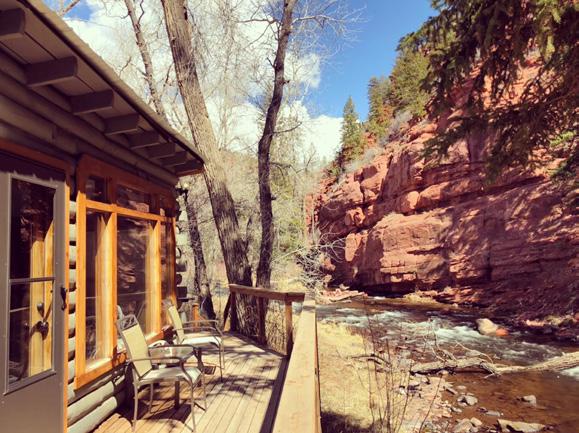


be a great addition to an indicator or dry-dropper rig, they are essential to the euro nymphing rig. When euro nymphing the key is to go bigger, go heavier, and add more heavy metal!

Gettin’ Jiggy Wit’ It
You read that right! I just made a reference to Will Smith’s 1997 hit song “Gettin’ Jiggy Wit’ It,” and if you don’t like it Smith will smack you like Chris Rock at the Oscars! While many euro nymph patterns are tied to traditional nymph hooks, the new wave of euro patterns are tied to jig hooks with wide hook gaps. The jig hook changes the orientation of the fly, directing the point of the hook towards the surface of the water instead of the snag-covered bottom of the river. This orientation towards the surface enables these unique patterns
High Country Angler • Spring 2023 www.HCAezine.com 36
Book Today! 210.336.2613 thedallenbachranch.com thedallenbachranch@gmail.com ‣ Private Frying Pan access ‣ Minutes from downtown @shyanneorvis 2561 Frying Pan Road, Basalt ‣ Riverfront cabin rentals ‣ Weddings & special events
to bounce and drift between rock and in front of the fish as they hold and feed along the bottom of the river, while the wide gap between the point and shank of the hook ensures that the flies bite back and will grab and hold onto a larger piece of meat than your standard nymph hook.
Swing with Motion & Flash
The vast majority of euro nymph patterns don’t attempt to closely imitate specific hatches but are in large part flashy, highly active attractor patterns capitalizing instead on their looks to seduce a strike from trout. Bright colors, fluorescents, wire wraps, metallic sparks of light cast from beadheads and flashbacks, and the realistic flowing of insect legs and tails created by wraps of soft hackle and CDC are the norm for the most productive euro nymphs in the fly box.

These heavy metal, sexy bombers are the apex predators in the fly fishing ecosystem! If you aren’t convinced of the appeal and high functionality of euro nymphs, try tying some on your next trip to the river and let your fish count convince you!
About The Author
Peter Stitcher is an Aquatic Biologist and owner of Ascent Fly Fishing. Originator of the Biologist Crafted Fly Selection, Peter and his team build their clients’ fly selections specific to the bugs in the waters they fish, when they fish them. You can contact Peter or restock your fly box at: www.ascentflyfishing.com.
www.HCAezine.com Spring 2023 • High Country Angler 37
FIT TO BE TIED • BY JOEL EVANS
Hunting for Trout with a 30-06
Fly fishing for trout has many parallels to big game hunting. Stealth in approach, camouflage clothing, seeking out edges and breaks, and equipment that matches the pursuit of the quarry at hand are factors for a successful hunt. Fly fishing uses the same strategy to remain unnoticed by the watchful eyes of a feeding trout.
But just as in hunting where sometimes the biggest gun is not the best gun, fly fishing sometimes eschews the mega streamer for the tiny midge. In my 50-plus years of fly fishing and 40-plus years of tying, “tiny” has been regularly redefined and downsized with each passing decade. When my Dad schooled me in the 1960’s on the fast waters of the Roaring Fork River near Aspen, Colorado, a size 10 Rio Grande King was the typical silhouette. Tiny meant stepping down to a size 12 Renegade.
and smaller patterns.
Size 14 commonality gave way to 16 and 18 in fly boxes, which eventually gave way to 20 and 22 plus, meaningful or not. Monofilament manufacturing advanced also, with leader and tippet being produced with an ever smaller diameter for the same pound test. Ever smaller tippets could be

THREAD : RED 14/0
CEMENT: UV THIN
BODY: THREAD
Several fishing factors at that time contributed to what are considered large flies today. First, there weren’t as many fishermen and hence not such pressured fish. Also, most tying materials of that day were natural materials, which dictated the techniques of larger size patterns. Not that fish have become evolutionarily smarter, but with more fisherman in more places, the downsizing of patterns helps fool pressured trout. Plus, the smaller bulk of increasingly available synthetic material selection accommodates smaller hooks
TAIL: OPAL RIBBON FLOSS, BRAID UNWOVEN TO INDIVIDUAL STRANDS
LEGS: OPAL RIBBON FLOSS, BRAID UNWOVEN TO INDIVIDUAL STRANDS
threaded through ever smaller hook eyes.
To a point. Which brings me to today’s pattern. A size 30 hook. Typically hook manufacturing has the hook eye decreasing as the hook size decreases. Not trivial, the 30 is intentionally made with a larger hook eye, similar to a size 20-something.
High Country Angler • Spring 2023 www.HCAezine.com 38
HOOK: GAMAKATSU C12-BM SIZE 30 BARBLESS MIDGE, LARGE EYE
GRIFFITH SHEER
PLAY VIDEO
So I’ve named this the 30-06 to draw a parallel to a popular caliber hunting rifle - size 30 hook lashed to a size 6x tippet. Now, while 30 and 06 are a workable combination, this can be adapted up or down, for example 30-07 or 28-06. Mostly to keep from losing the speck of a hook, it occurred to me to pre-tie a tippet to the hook at the tying table while still locked in the vise. Avoiding knots and dropped hooks on the river seemed laughingly brilliant. Tie on a 12-18” length of tippet at the vise, leaving the butt end free to somewhat easily knot to a leader, or tag with a surgeon’s knot on the river or lake. I have also put a tippet ring on the butt end to accommodate a knot, but mostly for security to avoid losing it all.
No right or wrong in fly tying. Change the color, change the ribbing, change the tail or wing or legs, but have fun target shooting!
About The Author
Joel Evans is president of the Gunnison Gorge Anglers chapter and the current Southwest Regional Vice President of Colorado Trout Unlimited.
• Walking distance to the gold-medal waters of the Gunnison River


• Near Blue Mesa Reservoir
• Vintage charm and ambiance
• Great outdoor space
• Multiple room layouts
• Fully stocked kitchens
• Spacious boat parking, including free long-term for multiple stays
www.IslandAcresResort.com

www.HCAezine.com Spring 2023 • High Country Angler 39 Save 10% - Use Promo Code HCA1703 Offer Expires 6/30/2023
Island Acres 38339 US Hwy 50 Gunnison, CO 81230 970.641.1442
WATCH TRAILER
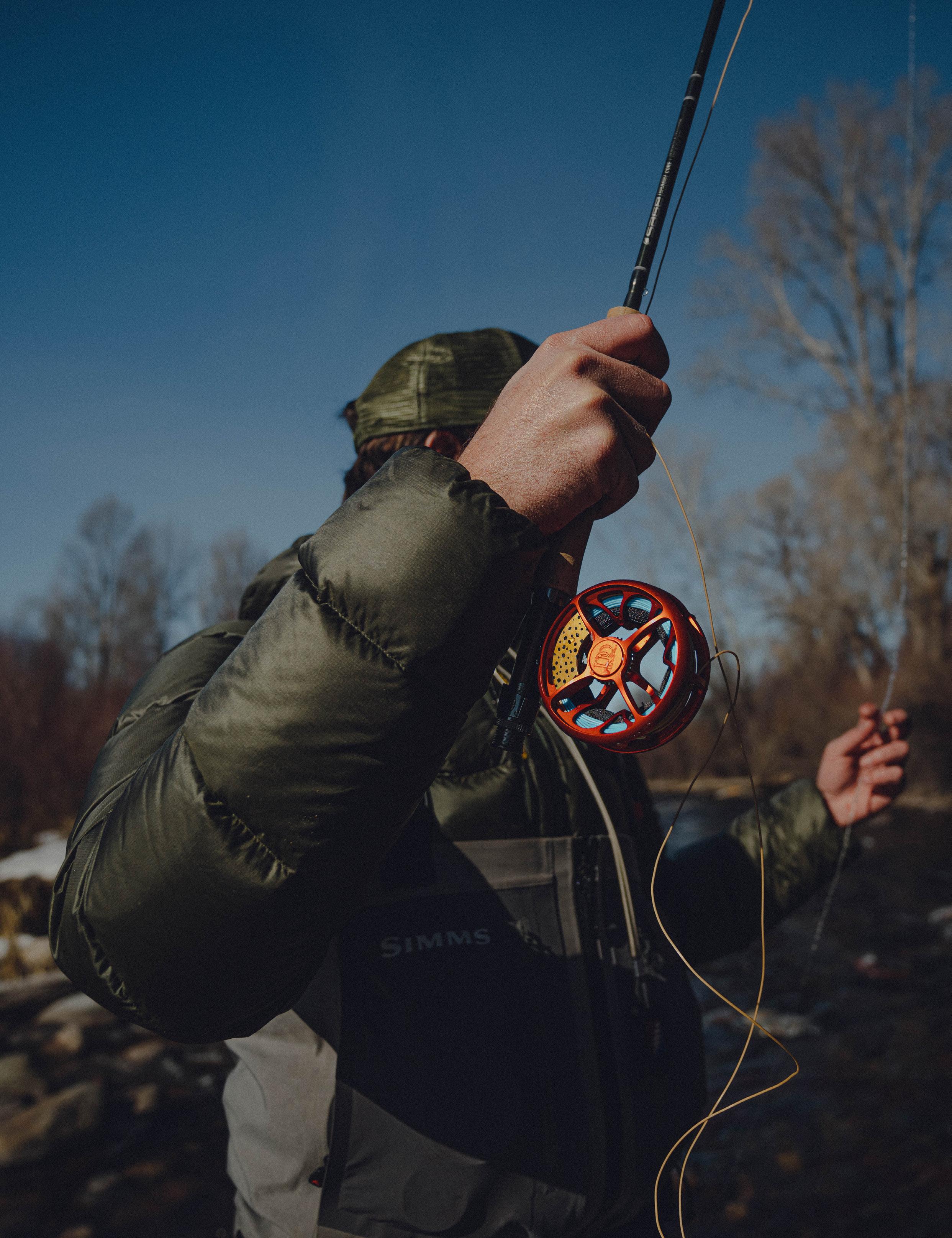
Reel Good News for Greenback Restoration
by Colorado TU Staff
At the February Fly Fishing Show in Denver, Mayfly Outdoors and Colorado
Trout Unlimited unveiled a limited-edition Greenback reel as part of a new Native Reel Series. The collaboration will generate awareness and funding for restoration of the Greenback cutthroat trout.
Inspired by the state fish of Colorado, the first reel in the series is built on a Ross Reels Colorado 2/3 – perfect for the small headwater streams where Greenbacks can be found. It is the first Ross Reel to be anodized in a dark orange color— meant to capture the colors of the spawning cutthroat trout, as well as the first to include hand painting on the clicker plate based on the cutthroat’s spots.

On each of the 495 limited-edition reels produced, Mayfly Outdoors will donate a portion of the purchase price directly to Colorado Trout Unlimited in support of the Poudre Headwaters Project, which is focused on restoring a large stronghold for native greenback cutthroat in its
original South Platte River basin.
“We are extremely excited to partner with Mayfly Outdoors and appreciate their dedication to restoring and protecting Colorado’s native trout,” said CTU Executive Director David Nickum. “Greenback cutthroats are near to the heart of many Colorado an-
www.HCAezine.com Spring 2023 • High Country Angler 41
glers, and with Mayfly’s support, we can secure a longterm future for these unique fish.”
Jeff Wagner, CEO of Mayfly Outdoors (Ross Reels, Abel Reels, Airflo Fly lines, and Dyna-King Vises) noted, “As a member of the greater fly-fishing industry and as stewards of our lands, we, therefore, have an obligation and duty to conserve and protect our

native fish heritage and our river ecosystems that are the lifeblood of the lands we enjoy. It’s the least we can do to partner with Trout Unlimited and help in their efforts to conserve, protect, and restore river habitat in order to preserve existing populations and reintroduce native fish. This mission is not just for today, but for generations to come.”
The Poudre Headwaters
Project is a multi-year effort to restore Greenbacks into some 40 miles of connected habitat in the Roosevelt National Forest and Rocky Mountain National Park. The project entails construction of both permanent barriers to secure habitat, and temporary barriers to break the watershed into manageable chunks for removal of nonnative fish and reintroduction of Greenbacks. The first major barrier – on the Grand Ditch at La Poudre Pass – was completed last year, while continuing work is slated for more than a decade ahead. Revenues from the Greenback reel will help sustain that work, leveraging other state and federal funds as well as a mitigation Trust put in place by the Water Supply and Storage Company. The Rocky Mountain Flycasters chapter of Trout Unlimited is providing extensive volunteer leadership and support for the project as well.
Anglers interested in purchasing one of these special reels should contact their local Ross Reels dealer or sign up for a pre-order waiting list online at www. rossreels.com/nativereels
High Country Angler • Spring 2023 www.HCAezine.com 42



For More Information: coloradotu.org/nativereel
THE ENDLESS RIVER
by Jack Bombardier
Ilive along the Colorado River, and throughout the year its changing moods are always interesting to observe. Sometimes the river runs low, and sometimes it runs high. There are times when it’s as clear as vodka, and others when it looks like chocolate milk (sometimes that can be in the same day). I’ve seen trees and oars and coolers and full beer cans and dead beavers and people (live) floating by in it. It can be as warm as bath water, and cold enough to make your genitals disappear if you fall into it during the wrong time of year. On some trips, anything you throw into it seems to get gobbled by a trout, and other days it takes nothing less than a stick of dynamite to move a fish. But in the winter, it can seem to the naked eye like it’s not even a river at all. The Upper C gets cov-
ered under a blanket of snow and ice, and seems like it ceases to exist. The crowds of the summer are long gone, and the River Road goes quiet.

This can be one of the nicest times to be here. Bald eagles are still stalking the few pieces of open water, mornings and evening the deer and elk can be seen crossing the road, and otters are easy to spot against the frozen banks. In the morning, the trees and shrubs along the river form an icy coat caused by the disparity between the water and air temperatures. This causes the river to look like it’s got crystal chandeliers along its length—at least for an hour or so before the sun melts it.
But the river is not dead, or even dormant. Under that ice, the river keeps flowing with all the force
High Country Angler • Spring 2023 www.HCAezine.com 44
it’s had all year, though it’s just hiding from view. The river never sleeps, for it’s always there flowing by with its ceaseless, perpetual power. It might not be visible to the naked eye, but every second of every day of every month of every year that ole man river, he just keeps rollin’ along. Even though I may not be floating on it, or swimming and fishing in it, the river remains a big part of my life. That’s because I shovel that snow off of it where it flows past my backyard, and ice skate on it. Some years I get to enjoy that experience for longer than others. There was one winter that we got almost no snow at all, but that made great conditions for river ice. Other winters there's excellent ice until we get a big snowfall, and then with the snow too deep to move by hand, the skating season comes to an early end.
This winter has been great, though. It got cold early, and I was on the river by Thanksgiving weekend. Most years, it’s not safe to venture out on until Christmas. For most winters, there's a week of chinook weather that warms things up, but we really haven’t seen that this season. It started cold, stayed cold, and is still cold. As a result, the river ice in my backyard is still two feet thick. It usually starts to melt off around Valentine’s Day, but not this year.
This winter, the ice has been perfect—maybe the best ever. Since the water was so clear and froze so quickly, you can look down into it and see suspended bubbles in it, like a lava lamp. Preparations for skating actually began before the ice even formed, back in the late fall. We had a low water year in 2022, which caused algae blooms to form. When the river level dropped in November, that algae now floated to the surface. If I allowed the ice to form with that algae in place, it would make for a bumpy, uneven surface, so it had to go. I wadered up and went out a couple of times with a rake and dragged it out. If anyone saw what I was doing it would have made for a strange sight (for who rakes a river?), but I knew that it would make a big difference once the ice formed. I also keep my dory tethered up to my dock for most of the year, so I can go out for a row whenever the mood strikes. I was also able to dislodge a lot of algae by putting my boat on top of it, and rowing hard back and forth.
When the cold weather finally came and the ice began to form, I used my dory like an icebreaker to ensure that we got a nice, flat sheet to begin with. When the ice forms slowly, it makes ridges each morning as
it grows. The first onset of ice was full of ridges, so I would forcefully backrow my boat onto it to break the bumpy ice off. Again, to anyone watching this process it would have looked very strange. Finally, when the really cold weather came in, I was little late getting my boat out of the river, so it got stuck in the ice like Shackleton’s ill-fated Endurance. I had to chop it out with an axe, and then hack away a spot to get my trailer into the river to pull it out.
But all that effort paid off for once. The cold weather came in early and it stayed cold, which it doesn’t always do. One year we had our normal early weather and the river froze, but a warm spell in December melted it all off and my wife and I did a float on Christmas Day. Not this year. By Thanksgiving weekend, it had already frozen to the point that I could get out on it, and that usually doesn’t happen until the end of December. The first few times I go out onto the ice, I usually wear neoprene waders, a PFD, and have a long rope nearby, just in case. I went through the ice years ago trying to get a dog out, and don’t want to ever experience that again.
The mountains have gotten lots of snow this year above 8,000 feet, but down here at 6,200 feet it’s been more limited. There’ve been plenty of mornings that we’ve woken up to an inch or two of fresh powder, but I’m able to clean that off the river ice using a wide plastic push shovel. The resulting ice surface I’ve been able to maintain is about 350’ long, and from 15’ to 25’ wide. Over twenty years of trying to create skateable ice, I’ve learned that as long as I can keep the snow off of it, the sun will usually do the rest. Each day the sunshine micro-melts the surface, and then it refreezes at night, so each day it becomes better and better. Right now, the ice on the river is extremely smooth. There are some cracks to be wary of, but they’re pretty obvious.
A couple of weekends ago, I invited over some friends with kids to play hockey on it. It was great to see them enjoying the outdoor the way I did as a little kid. Growing up, I learned to play hockey on frozen ponds in New England. When I got older, I played on indoor rinks for youth and high school hockey, but it never felt as free and open as being outside. I always felt like a great pond hockey player, but once I put on a helmet and pads and was surrounded by refs and lights and horns, I was never more than average. There’s just something special about skating
www.HCAezine.com Spring 2023 • High Country Angler 45
outdoors, and it doesn’t matter whether it daytime or nighttime. Last week was especially beautiful, as the full moon lighted up my rink and gave everything a blue glow. There was no need for a headlamp, for the moon and solar lights lining the ice surface was all that was needed.
It’s now the middle of February, and the ice won’t be on the river for much longer. On most years its already begun to melt off by now, and so I’m just going to try to appreciate it for as long as I can. It was warm enough today to really soften up the ice, and a reminder that spring is just around the corner. When I got home from work it was dark, and before going inside I decided to see what effects the day's sunshine had created. Approaching the river, I was initially disappointed. The sun had turned my ice back into its liquid form, and so my ice skating might be done for the year. But then as I got closer, I realized that it wasn't water yet, it was still ice, but just so smooth that it looked like liquid. That was all it took to put a big gust of wind into my sails, and even after a hard day of work I was energized enough to go get my skates.
Sometimes I skate with music playing through Bluetooth headphones. Last night I couldn’t decide what to listen to, so I decided to just choose an album at random. The music my fingertip found was “The Endless River” by Pink Floyd. This made me smile, for with a title like that it seemed to be the perfect choice. It’s not a great album but it has its moments, and it was a perfect soundtrack for the skating I did on the river’s surface that night. The ice was so smooth that I could see the stars reflected on its gleaming surface. The river looked and felt like it was in a liquid state, not frozen. This was like low level flying, like one of those swallows I love to watch in the summer whiz by snatching up hatching caddis flies. Skates allow one to move in ways not possible in any other manner. You can swirl and cut and glide and spin and feel more like a god than a mere human.
I wasn’t planning to be on the ice as long as I was last night, but just couldn’t help myself. I’d skate up and down the length of the ice in a straight line, or cover the expanse of it—making zig zag patterns from one side to the next. In spots I’d just make tight circles going clockwise, then form a figure eight by circling hard in the opposite direction. All sense of time and space got distorted until it finally became irrelevant. Sometimes I’d use my LED hockey puck and practice
stickhandling and shooting on my goalie net, which is adorned with solar minilights. After Pink Floyd, there were other good tunes playing in my headphones, and it seemed like every time I’d think about stopping some new good song would start, and I’d keep on skating hard for another five minutes. Before I knew it, I looked at my watch and realized that more than three hours had elapsed since I first strapped on my skates. I was beginning to feel a bit tired, and ready to quit, but then another great song would start…
The best thing about this winter is what it portends for the rest of the coming year. A big healthy snowpack is just what we’ve been needing for a long time. The last time the snowpack looked like this was in 2011, and that was the year the Colorado River reached 12,000 cfs, and my backyard was under water for two months. I don’t expect to see that kind of volume this year, since the reservoirs are lower to start than they were then, and the snow now melts off earlier than it used to. But still, we should have some kind of runoff this year, and with that a decent flushing flow that the riverbed could really use.
It’s been a long time since we’ve had a good runoff on the Colorado River, and even though I’m primarily a float fisherman, I really enjoy running whitewater. Now that I’m on the wrong side of sixty years old, I’ve been wondering if there would ever be another good water year in my lifetime. After all, if I were an hourglass, there would be more sand in the bottom of it than there is left in the upper half. But this is looking like the year that I and every other river lover in Colorado has been waiting for. 2023 is off to a great start, and I can’t wait to see what the next few months will look like! About
The Author
Jack Bombardier is the owner of Confluence Casting and guides on the “lower Upper” Colorado River above Dotsero. He also serves on the Upper Colorado Wild & Scenic Management team, charged with collaborating to protect the river’s outstanding values.
High Country Angler • Spring 2023 www.HCAezine.com 46

Are any surface waters in the United States safe for human use? Are the fish in these waters safe for human consumption? Is it even safe to handle fish from contaminated waters?
I have seen several recent news reports that have explained dangers related to “Forever Chemicals.” Some reports claim that these are common substances with many everyday uses; that they are used so widely that they are ubiquitous across the entire planet; that they are toxic to many forms of life at very low concentrations; and that they degrade so slowly that they must be considered to be “forever chemicals.” Do you think there are solutions to these forms of pollution and that anglers can continue to enjoy their sport?
The Scourge of “Forever Chemicals” Q A
“Forever chemicals” are a very serious, world-wide problem, the importance of which is just beginning to be recognized. I will not try to provide a potential solution for this emerging problem, but can offer a few bits of advice for anglers. However, all of us should realize that the problems caused by PFAS substances (forever chemicals) extend far beyond fishing and fishers.
Per- and poly- fluoroalkyl substances (PFAS) are organic compounds that have been used for a variety of purposes for the last 80 years— mostly as surfactants. Uses include coating non-stick cookware, food packaging, water resistant clothing, stain resistant carpets and
furniture, cosmetics, protective coatings, and firefighting foams. The wide variety of uses and their virtually nondestructive nature of PFAS, results in them being spread, and accumulating, everywhere on Planet Earth. The qualities that make them valuable for human uses unfortunately make them accumulate in strong concentrations in the water, soils, plants, and animals of our planet. Only recently have the negative effects of PFAS on humans started to be realized. PFAS may be wonderful, but they are a “mixed blessing” with serious side effects.
Human experiences with pollutants, whether air, water, or soil have primarily been “point sources” where the source is visible, and the primary effects are immediately detectablesuch as a discharge pipe, a surface flow, or a smokestack. PFAS discharges are different. They remain blended into the air, water, or soil, and are only detected through careful sampling and laboratory analyses. The harmful effects of PFAS substances have been slow to be identified and often confused with other possible causes. Recently PFAS substances have been linked to such health problems as liver, kidney, and testicular cancer. Other health issues related to PFAS substances include lower birth weights, increased risk of asthma, infertility, thyroid disease, and miscarriage, plus several others.
Recent testing has revealed that PFAS substances are present everywhere, with the possible exception of Antarctica. Fish and other aquatic animals have accumulated easily detected concentrations, especially in areas close to concentrated human populations and human activities, including agriculture. Contaminated water, soil, and air conditions vary in
High Country Angler • Spring 2023 www.HCAezine.com 48
THE LAST CAST • JOHN G. NICKUM
concentrations, but the fact that the contaminants are invisible and most of their effects are not obvious has hidden from the public the problems that they cause.
An angler fishing in a stream or lake where the water and the fish are contaminated with “forever chemicals” may not realize the potential problems. Fish carrying substantial concentrations of PFAS generally will not show obvious signs of the chemicals and will behave as relatively normal animals. An angler practicing “catch and release” probably would not be in any danger for subsequent health problems. “Catch and consume” is a different story. Health experts are advising against consumption of fish from most inland waters. Fish from ocean waters or cold spring flows at high elevations have demonstrated lower levels of contamination.
Looking forward, “forever chemicals” will probably be a problem for consumers of freshwater fish for the foreseeable future. Insecticides, such as DDT that were used widely in
post World War II years, continued to contaminate waters long after their use was banned. A former colleague of mine found DDT in the runoff from Iowa cornfields following thunderstorms for 15 years after the use of DDT stopped. The PFAS (“forever chemicals”) have far slower rates of chemical degradation. They will be contaminating our air, water, soils (and fish) for the foreseeable future.
Anglers do not need to abandon their sport. With carefully exercised selections, consumption of fish from sources that have been tested may be acceptable. Catch and release is the recommended answer for trout anglers for the foreseeable future.
About The Author
John Nickum, is a retired PhD. fishery biologist whose career has included positions as professor at research universities including Iowa State and Cornell University, director of the Fish and Wildlife Service’s fisheries research facility in Bozeman, MT, and science officer for the Fish and Wildlife Service’s Mountain-Prairie Region. He was inducted into the National Fish Culture Hall of Fame in 2008.
www.HCAezine.com Spring 2023 • High Country Angler 49
"An angler fishing in a stream or lake where the water and the fish are contaminated with “forever chemicals” may not realize the potential problems."
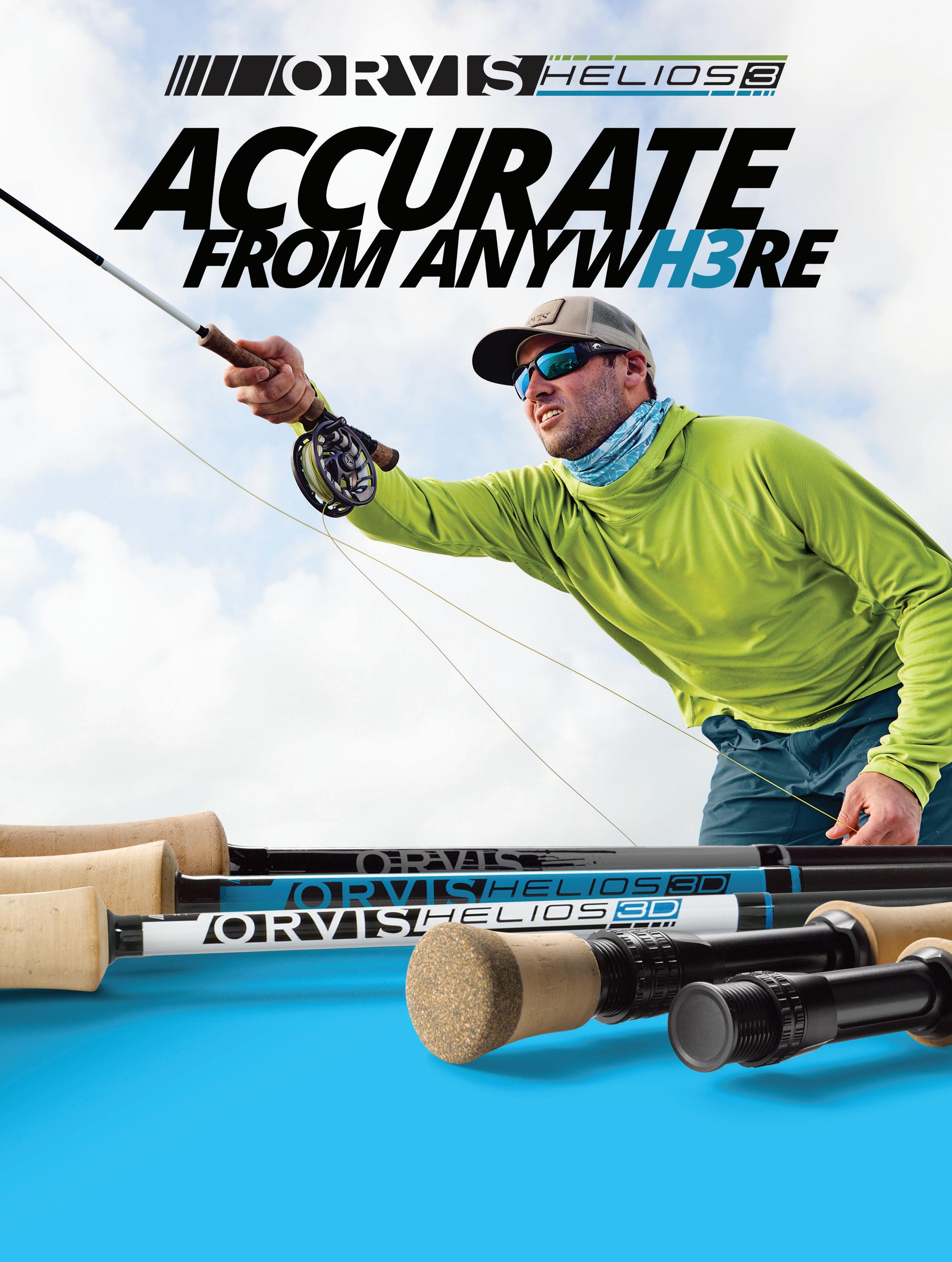
Orvis Authorized Dealers Anglers All, Littleton, CO Anglers Covey, Colorado Springs, CO Avidmax, Centennial, CO Blue Quill Angler, Evergreen, CO Breckenridge Outfitters, Breckenridge, CO Front Range Anglers, Boulder, CO Golden Fly Shop, Golden, CO Kirk’s Fly Shop, Estes Park, CO Minturn Anglers, Minturn, CO Royal Gorge Fly Shop, Cannon City, CO Trouts Fly Shop, Denver, CO Orvis Company Stores Cherry Creek Park Meadows Experience the difference for yourself by test casting the H3 rod, and stock up on all the fly-fishing gear you need at one of our Colorado locations today!









































 by Brian La Rue
by Brian La Rue
























 by Joel L Evans
by Joel L Evans









 by Peter Stitcher
by Peter Stitcher







































